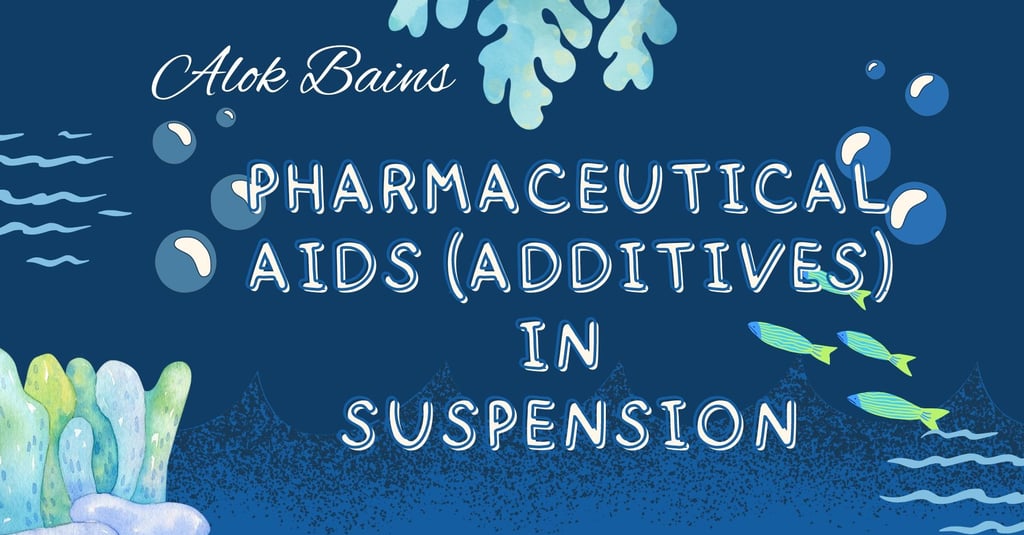Pharmaceutical aids Suspension
Pharmaceutical aids (additives) in Suspension for dispersion of solids. Water Miscible Co-Solvents, Flocculating Agents, Wetting Agents, Suspending Agents, thickening Agents, Preservatives, Organoleptic Additives
PHARMACEUTICS
12/14/20231 min read


Pharmaceutical aids (additives) in Suspension for dispersion of solids. Water Miscible Co-Solvents, Flocculating Agents, Wetting Agents, Suspending Agents, thickening
Pharmaceutical aids (additives) in Suspension:
The following additives are most commonly used in the suspension formulation for the dispersion of solids, preservation, and acceptability by the patient. The flocculating agents, wetting agents, and suspending agents are used to disperse solid particles in the water and to improve suspension physical stability.
A. Pharmaceutical aids (additives) in Suspension for dispersion of solids:
Most of the API in suspension is hydrophobic in nature. They are processed to increase the intimate contact level between water and solid particles. This is the dispersion of solid particles in a liquid medium. Dispersed solid particles in the medium is called dispersed phase.
Solid particles are powdered to form fine powder to facilitate their dispersion and increase the physical stability of the suspension. Fine insoluble solid particles have a tendency to trap air in the liquid medium and form large agglomerates. Air-trapped agglomerates float on the liquid surface despite the high density of the solid particle. It will be difficult to expel air from the air-trapped agglomerates.
Intimate contact between the liquid medium and the dispersed phase depends on the wetting ability of the liquid medium (dispersion medium). This can be ascertained by measuring the contact angle made by solid particles on the surface of a liquid medium.
To solve this problem Flocculating agents and water miscible co-solvents are used to increase the wetting ability of the liquid medium.
1. Water-miscible co-solvents: Common examples of water-miscible co-solvents are alcohol, glycerine, propylene glycol, etc. Water-miscible agents form a coat over insoluble solid particles. This blocks the contact of water with insoluble solid particles. Water is miscible with water-miscible agents coating the solid particles. That will facilitate the dispersion of solid particles in water. Solid particles will be in a deflocculated state in the water.
2. Flocculating agents: Surfactants and protective colloids are used as Flocculating agents. They are used to improve the dispersion of solid particles in water. Surfactants decrease the interfacial tension between water and solid particles. This increases the contact angle, and wetting ability of the water and lowers the solid fine particles' tendency to entrap air. Some surfactants are charged ions in the water medium. They are adsorbed on the surface of suspended particles and develop negative charges on the suspended particles. Similar charged particles repel each other. It prevents or minimizes flocculation. Sodium lauryl sulphate, and sodium dioctyl sulphosccinate are examples of ionic surfactants. Nonionic surfactants also usually assume negative charges in the aqueous solution and act as effective flocculating agents. Examples are tweens, spans, carbowaxes, etc.
3. Wetting agents: Water miscible co-solvents and Surfactants act as wetting agents. They are adsorbed at the solid-liquid interface to reduce interfacial tension. This increases the affinity between solid particles and the surrounding medium. Each surfactant has an HLB value. Surfactants with HLB values in the range of 7 to 9 are used as wetting agents. The minimum amount of surfactants should be used because they have a tendency to form foam during mixing. Examples are alcohol, glycerine, glycol, polysorbates, etc.
4. Suspending agents/ thickening agents: They are used to increase the viscosity of the dispersion medium. They should be selected carefully. They should increase the viscosity of the suspension while maintaining their pourability and spreadability. They are natural and semi-synthetic. Examples of natural suspending agents include acacia, tragacanth, sodium alginate, etc. Examples of semi-synthetic suspending agents are methyl cellulose, carboxy methyl cellulose, hydroxyl propyl methyl cellulose, synthetic polymers, and gelatine. Nonionic substances like sorbitol, glycerine, polyethylene glycol, etc are also used to increase the viscosity of the suspension.
B. Pharmaceutical aids (additives) in Suspension for preservation (Preservatives): Suspending agents, medicaments, and aqueous medium favor microbial growth. This requires preservatives to be added to the suspension. Preservatives should be physically and chemically stable compounds that should be effective against a wide range of microorganisms. They should be nontoxic to humans and compatible with the other ingredients in suspension. Examples are benzoic acid methylparaben, propylparaben, sodium benzoate, etc.
C. Organoleptic additives: Colouring agents, sweetening agents, and flavoring agents are used in oral suspension. Similarly, perfumes are used in the suspension for external applications.
Alok Bains
